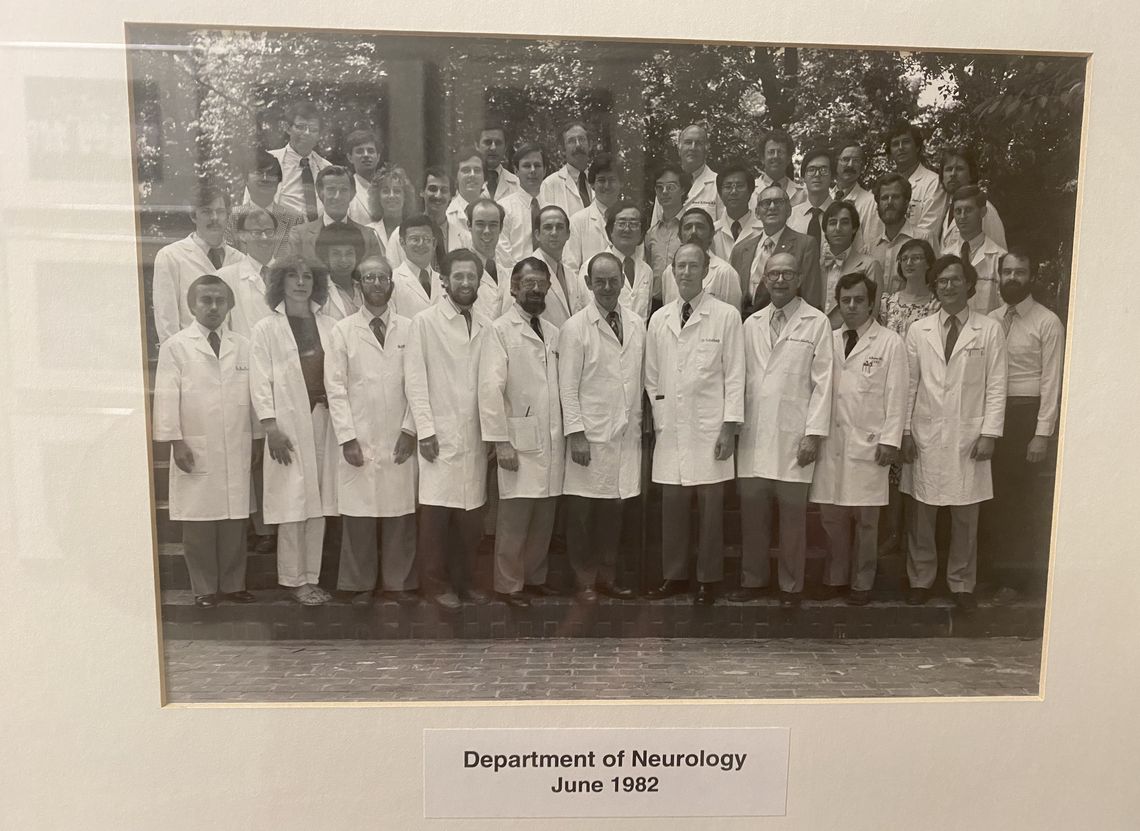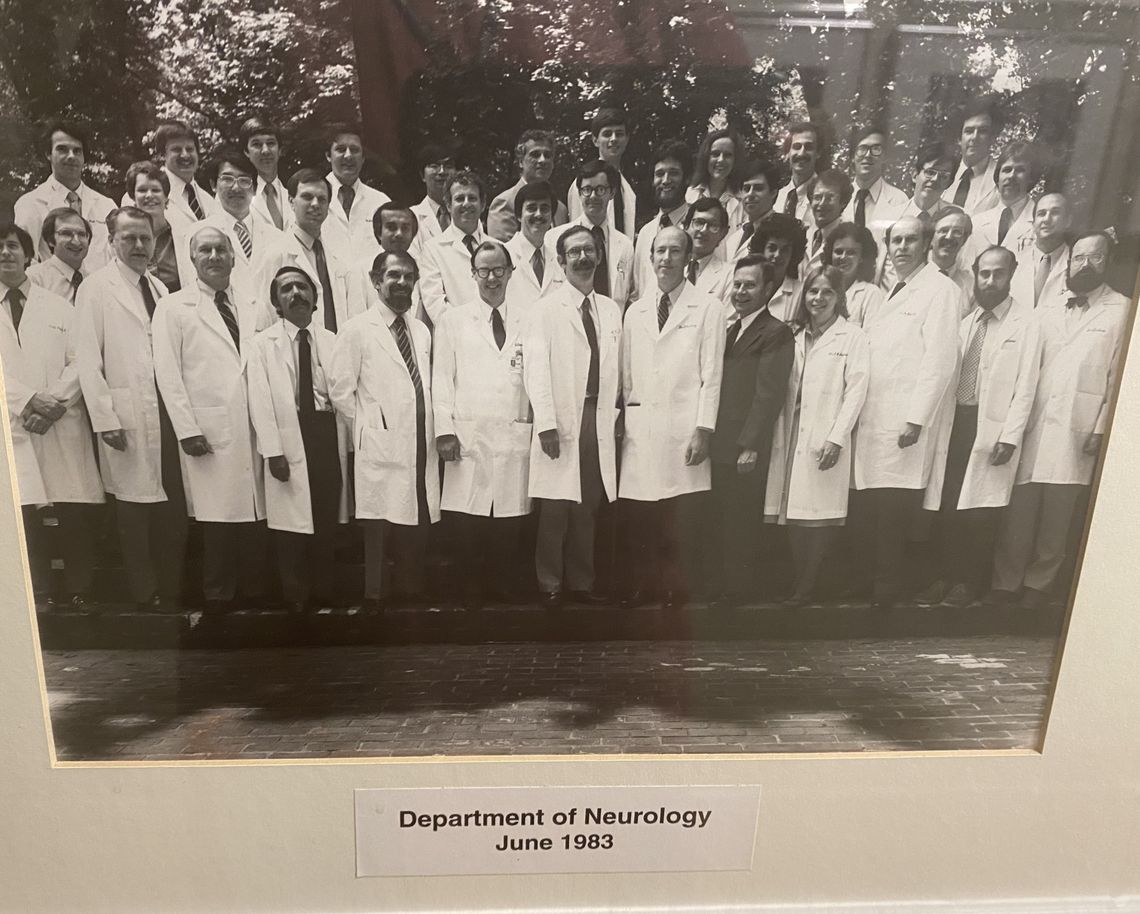- Our History
- The History of Neurology and Timeline
- Timeline
- Donald H. Silberberg, Chair
FACULTY INTERVIEWS
Dr. Amy Pruitt interviews Dr. Don Silberberg: Check out a snippet of former chair Dr. Don Silberberg talking about his successes and regrets
View the full video here: Silberberg Interview: full and snippets
Dr. Larry Brown interviews Dr. Amy Brooks-Kayal: Amy Brooks-Kayal discusses diversity and inclusion: Review the full video here: https://youtu.be/jBpS-uBdwak
Donald H. Silberberg, Chair, 1982 — 1994
 Dr. Silberberg is Professor Emeritus of Neurology, former Neurology Chair, and former Senior Associate Dean for International Medical Programs, University of Pennsylvania School of Medicine. After undergraduate studies at the University of Michigan, he received his MD at the U. Michigan. While in medical school he began research in the Rackham Arthritis Research Institute; summers permitted opportunities to work in research laboratories at the National Institutes of Health as a member of the USPHS Commissioned Officer’s Training Program (COSTEP). His neurology residency training was at NIH as a Clinical and Research Associate, under Dr. G. Milton Shy, and neurology and neuropathology at the National Hospital, Queen’s Square, London, England, as a Fulbright Fellow. Following this he trained in neuro-ophthalmology as an ophthalmology resident and NINDB Special Fellow in Neuro-Ophthalmology, Department of Ophthalmology, Washington University School of Medicine, St. Louis. In 1963, he joined Dr. Shy’s successful efforts to re-build the Department of Neurology at Penn, becoming one of the initial four full-time faculty members in the department.
Dr. Silberberg is Professor Emeritus of Neurology, former Neurology Chair, and former Senior Associate Dean for International Medical Programs, University of Pennsylvania School of Medicine. After undergraduate studies at the University of Michigan, he received his MD at the U. Michigan. While in medical school he began research in the Rackham Arthritis Research Institute; summers permitted opportunities to work in research laboratories at the National Institutes of Health as a member of the USPHS Commissioned Officer’s Training Program (COSTEP). His neurology residency training was at NIH as a Clinical and Research Associate, under Dr. G. Milton Shy, and neurology and neuropathology at the National Hospital, Queen’s Square, London, England, as a Fulbright Fellow. Following this he trained in neuro-ophthalmology as an ophthalmology resident and NINDB Special Fellow in Neuro-Ophthalmology, Department of Ophthalmology, Washington University School of Medicine, St. Louis. In 1963, he joined Dr. Shy’s successful efforts to re-build the Department of Neurology at Penn, becoming one of the initial four full-time faculty members in the department.
Dr. Silberberg's research initially focused on metabolic causes of neonatal injury, transitioning to exploring the basis of multiple sclerosis and related disorders of the nervous system. Pivotal results of his research were to: Establish the basis for phototherapy for children with hyperbilirubinemia; Demonstrate in vitro the neurotoxicity of the excess metabolites found in maple syrup urine disease and phenylketonuria; Identify the immunologic basis for treating Guillain-Barre syndrome; Demonstrate neurotropism of a corona virus in vitro; and demonstrate that Gadolinium enhanced magnetic resonance imaging identifies MS disease activity. He has published over 300 scientific reports, with support from NIH, the NMSS, the Ford Foundation and the University of Pennsylvania’s Research Foundation. Dr. Silberberg trained many students, residents, research fellows and faculty who subsequently developed distinguished careers in the US, Australia, India, Italy, Israel, Japan, and Switzerland.
Dr. Silberberg has worked to improve the recognition and care of individuals with neurological disorders in developing countries since his first field experience in Shiraz, Iran and surrounding villages in 1974. In the late 1980’s he participated in the analysis of epidemiologic data that was the subject of the World Bank’s 1993 seminal Annual Report, Investing in Health, the Bank’s first public recognition of health needs in developing countries.
He worked in Iran, Japan, England, and France, and served as visiting Professor in countries in Africa, Asia, Western Europe, The Middle East, and Russia, and served as a consultant to WHO, and to Ecuador’s National Assembly regarding development of legislation regarding epilepsy and disabilities.
The rest is from a very long CV.
Major Discoveries and Events at Penn during this time
- 1982 - In December, President Hackney nominated and the Trustees elected Shelley Z. Green to the senior administrative position of General Counsel. She became the first woman to serve as General Counsel of the University and the third woman to serve as a Statutory Officer of the University. Ms. Green had been Acting General Counsel for four months prior to her appointment and had previously held the administrative positions of Assistant and Associate General Counsel. Prior to accepting a position at Penn, she had served as a legal advisor to the U.S. Department of Health, Education, and Welfare. Ms. Green continued as General Counsel for sixteen years, before submitting her resignation in December 1998.
- 1983 - Edwin Meese, presidential counselor, and Wharton School Dean Russell E. Palmer were honored in Washington, DC at a ceremony promoting the LEAD Program. LEAD is described as “a pioneering attempt to strengthen minority enrollment in the nation’s leading business schools.” In the program, talented minority high school students are exposed to business curricula during the summer, to encourage them to pursue business education at the collegiate level. Penn was the first business school to participate and was soon followed by Northwestern, University of Michigan, Columbia, University of Maryland, University of Virginia, and the University of California at Los Angeles.
- 1993: start the Women Rise to positions of Presidency at the University of Pennsylvania:
- In December, the Trustees elected Judith Seitz Rodin (A.B., 1966), M.A., Ph.D., Provost of Yale University, the seventh President and Chief Executive of the University of Pennsylvania. She is the first alumna to serve as President of Penn and the first woman to serve as President of an Ivy League institution. She was the tenth woman to serve as a Statutory Officer of the University.
Major Translational Research and Clinical Advances during this era
- Immunologic studies provided the basis for plasmapheresis in GBS.
- The use of gadolinium MRI contrast to demonstrate active MS lesions was demonstrated.
- Measurement of cerebral blood flow via fMRI
- The ability of a corona virus to infect brain tissue in vitro was demonstrated.
- During these years, The Department of Neurology, not including Child Neurology, had the highest ratio of external research funding, mostly NIH, per faculty member of any clinical department, 2nd only to the Department of Physiology. Neurology also had the highest ratio of funding/net square feet of research space of any department, basic science or clinical.
- The use of immunological-based therapies, plasmapheresis and IV IgG, became accepted modalities for Guillian Barre Syndrome and idiopathic peripheral neuropathy, in part on the basis of clinical and laboratory research carried out in Penn’s Department of Neurology.
- Computer-based imaging became available including the advent of magnetic resonance imaging and positron emission tomography, both based on research carried out in Penn’s Departments of Radiology and Neurology. The PET developments were supported by the availability of radioisotopes produced the cyclotron facility established as part of the Cerebrovascular Research Center, organized by Martin Reivich. Dr. John Detre’s research that led to the ability to quantify regional cerebral blood flow by functional MRI was initially funded by the Department of Neurology.
- 1982: Research laboratories were housed in the Johnson Pavillion, the Stemmler Building and the cyclotron facility established by Dr. Martin Reivich in a below-ground floor of the Nurses Education Building. Dr. David Pleasure’s research was carried out in laboratories in CHOP.
- 1980: In the early 1980’s, with the use of what were termed ‘Education and Development Funds’ that the department had accrued, Neurology was able to share in building the Clinical Research building and thus was able to reserve and equipped the research space that it occupies in the CRB.
- Contemporary immunomodulatory treatment for multiple sclerosis began with availability of Copolymer-1 (Copaxone) and interferon beta (Betaseron and Avonex). Dr. Jeffrey Cohen agreed to manage Penn’s participation in an important multi-site clinical trial of Copaxone, leading to his subsequent career at the Cleveland Clinic focusing on clinical research in MS.
- Newly developed anti-epileptic drugs improved clinical outcomes; advances in epilepsy surgery made it an increasingly effective and acceptable treatment for many with seizures who could not be adequately controlled with pharmacologic agents.
- New Hospital of the University of Pennsylvania (HUP) buildings allowed substantial modernization of clinical facilities: the inpatient unit was moved from Ground Floor Gibson to Silverstein 9; the outpatient unit, EEG laboratory and the Neurovascular Laboratory moved from 3 Gates West to Ravdin 2.
- Stroke Centers were established in many sites, including Penn. Penn was among the first to treat acute stroke with tPA.
People of this era
CHOP/ Child NeurologyPeter Berman Lawrence Brown Robert Clancy Samuel Tucker Donald Younkin Peter Berman
|
Pennsylvania HospitalThomas Bosley David Cook Gunter Haas
|
Hospital of the University of PennsylvaniaArthur Asbury William Bank Robert Barchi John Bevilacqua Shama Bhat, PhD Eduardo Bonilla, PhD Mark Brown James Burns John Detre Marc Dichter Roger Farber Kenneth Fischbeck Myron Frederick (Presbyterian) Jacqueline French Steven Galetta Donald Gilden Myron Ginsberg Francisco Gonzales-Scarano
|
continued Hospital of the University ….
Joel Greenberg, PhD Murray Grossman Howard Hurtig Steven Jones, PhD Sami Khella Michael Kushner Joan Mollman David Pleasure Eric Raps Martin Reivich Mohammad Rostami Steven Scherer Donald Schotland Michael Selzer Michael Sperling Matthew Stern Austin Sumner
|
Joint Faculty AppointmentsBurton Zweiman, Allergy and Immunology, Dept. Medicine (joint appointment) Nicholas Gonatas, Neuropathology (joint appointment)
See Department Photos from this Era
|
|


 Annual Group Photos during Dr. Don Silberberg's Era
Annual Group Photos during Dr. Don Silberberg's Era